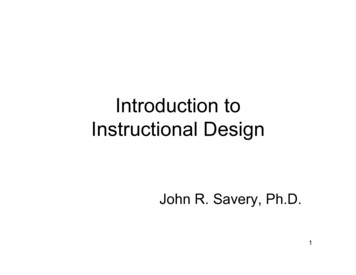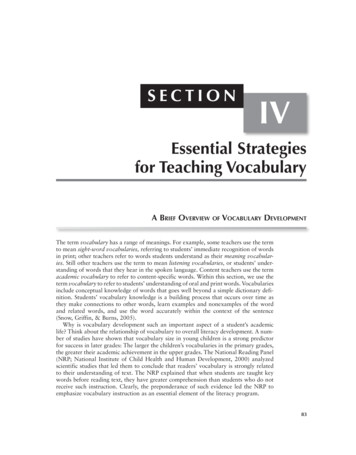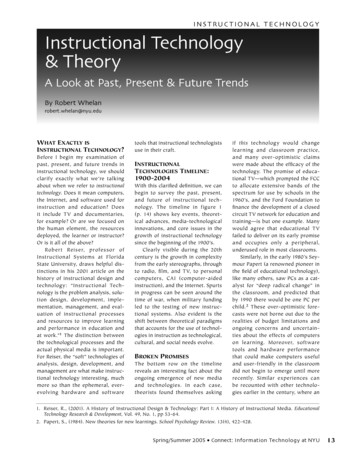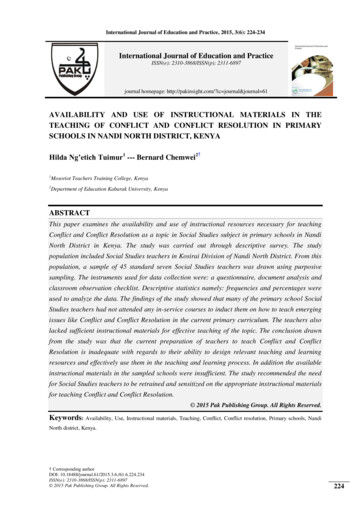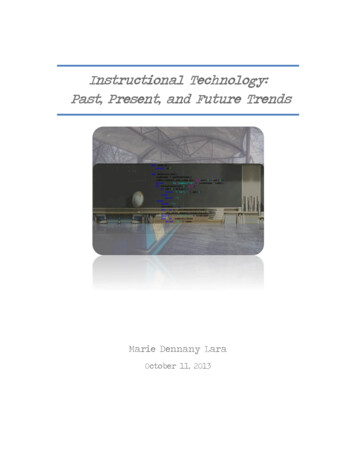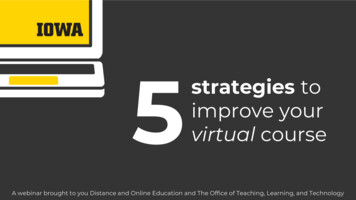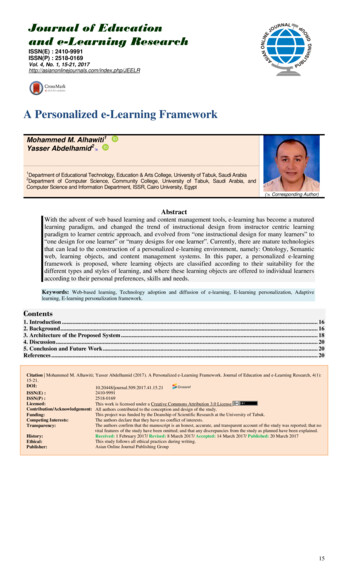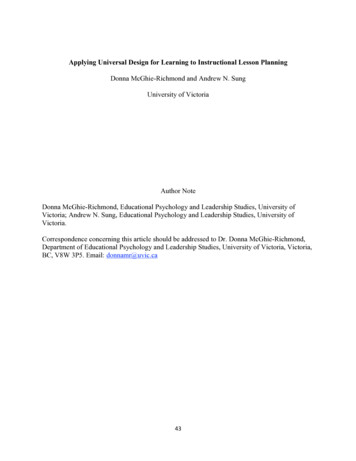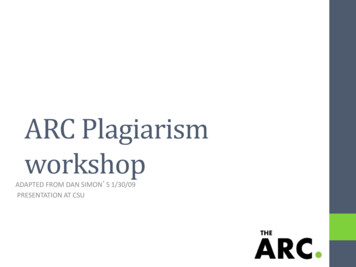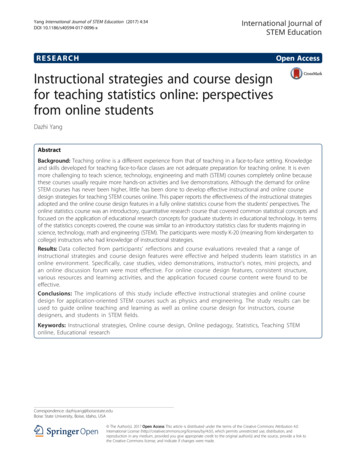
Transcription
Yang International Journal of STEM Education (2017) 4:34DOI 10.1186/s40594-017-0096-xInternational Journal ofSTEM EducationRESEARCHOpen AccessInstructional strategies and course designfor teaching statistics online: perspectivesfrom online studentsDazhi YangAbstractBackground: Teaching online is a different experience from that of teaching in a face-to-face setting. Knowledgeand skills developed for teaching face-to-face classes are not adequate preparation for teaching online. It is evenmore challenging to teach science, technology, engineering and math (STEM) courses completely online becausethese courses usually require more hands-on activities and live demonstrations. Although the demand for onlineSTEM courses has never been higher, little has been done to develop effective instructional and online coursedesign strategies for teaching STEM courses online. This paper reports the effectiveness of the instructional strategiesadopted and the online course design features in a fully online statistics course from the students’ perspectives. Theonline statistics course was an introductory, quantitative research course that covered common statistical concepts andfocused on the application of educational research concepts for graduate students in educational technology. In termsof the statistics concepts covered, the course was similar to an introductory statistics class for students majoring inscience, technology, math and engineering (STEM). The participants were mostly K-20 (meaning from kindergarten tocollege) instructors who had knowledge of instructional strategies.Results: Data collected from participants’ reflections and course evaluations revealed that a range ofinstructional strategies and course design features were effective and helped students learn statistics in anonline environment. Specifically, case studies, video demonstrations, instructor’s notes, mini projects, andan online discussion forum were most effective. For online course design features, consistent structure,various resources and learning activities, and the application focused course content were found to beeffective.Conclusions: The implications of this study include effective instructional strategies and online coursedesign for application-oriented STEM courses such as physics and engineering. The study results can beused to guide online teaching and learning as well as online course design for instructors, coursedesigners, and students in STEM fields.Keywords: Instructional strategies, Online course design, Online pedagogy, Statistics, Teaching STEMonline, Educational researchCorrespondence: dazhiyang@boisestate.eduBoise State University, Boise, Idaho, USA The Author(s). 2017 Open Access This article is distributed under the terms of the Creative Commons Attribution 4.0International License (http://creativecommons.org/licenses/by/4.0/), which permits unrestricted use, distribution, andreproduction in any medium, provided you give appropriate credit to the original author(s) and the source, provide a link tothe Creative Commons license, and indicate if changes were made.
Yang International Journal of STEM Education (2017) 4:34BackgroundOnline education, including innovative and responsiveonline course designs, as well as research on student opportunities to interact with online course content continues to grow in higher education. The widespread useof smartphones and mobile applications make onlinecourses appealing to students who conduct courseworkremotely, furthering the concept of learning anywhereand anyplace (Smith 2015). The Babson Survey ResearchGroup estimates over 6 million college students are currently enrolled in a distance learning program (Allenand Seaman 2017). At community colleges, the onlineeducation growth rate of 4.7% in 2014 was more thanthe college population growth rate (Smith 2015). A majority of higher education institutions consider onlinelearning as part of their strategic growth (Allen and Seaman 2015). In practice, online courses are increasinglybeing offered to maximize learning opportunities andreach more students.The demand for online science, technology, engineering and math (STEM) courses has never been higher,and more STEM instructors are teaching or will beteaching such courses online. However, teaching onlineis a fundamentally different experience from that ofteaching in a face-to-face setting (Davis and Snyder2012; Juan et al. 2011). Literature suggests that knowledge and skills developed for teaching face-to-faceclasses are not adequate preparation for teaching online(Deubel 2008). Instructors teaching online often find theexperience more difficult and time-consuming (York etal. 2007). It is even more challenging to teach STEMand other quantitatively oriented courses completelyonline because these courses usually require morehands-on activities and live demonstrations (Akdemir2010). For example, teaching an online experimentalscience course is acknowledged to be difficult (Mosseand Wright 2010) due to the required live demonstrations, associated safety concerns, and must-have equipment (e.g., lab supplies). It is also difficult to teachtechnology, engineering, and math courses completelyonline (Akdemir 2010). Despite these concerns, little hasbeen done to develop effective instructional and onlinecourse design strategies for teaching STEM courses online (Akdemir 2010).Instructional strategies, which refer to specificmethods and approaches that “provide the conditionsunder which learning goals will most likely be attained”(Driscoll 2000, p. 344), are critical factors impacting online learning and learning experiences (Fresen 2005;Schaller et al. 2002). Few teacher education programs inthe USA offer any training in learning theories or teaching pedagogies appropriate for online learning environments (Patrick and Dawley 2009). Most faculty membersin higher education “have little or no formal training asPage 2 of 15teachers” and tend to teach the way they were taught(Perrin 2004, p. 4). Additionally, simple, unaltered adoption of traditional instructional methods while teachingonline will not produce the desired outcome (York et al.2007). Untrained and unprepared STEM instructors aresometimes caught in difficult circumstances when theyare tasked to teach an online class. This untenable situation may have a dramatic effect on students’ perceptions of online STEM courses.Research showed that students’ perceptions of theiroverall learning experience with instructional strategiesand online course design not only affected their perceived learning but also their overall satisfaction of anonline course (Myers and Schiltz 2012). Even if therewas no significant difference between online and faceto-face statistics courses in terms of learning gains, therewas a difference between students’ perceived learningand learning experience (Summers et al. 2005). Althougheducators agree that math and statistics can be taughtonline despite their application-based nature (Akdemir2010), little has been done in developing effective instructional strategies for teaching such courses online(Bonk 2001). In addition, students’ perceptions and attitudes have not been adequately examined when investigating important indicators of successful learning inonline statistics courses (Myers and Schiltz 2012).Most previous studies examining the effectiveness ofonline statistics courses focused on learning gains(Myers and Schiltz 2012). Student perceptions of the instructional strategies adopted in their online courses, including reflections of the online course design, have notbeen adequately examined in such contexts. As such,this study focused on examining student feedback andperspectives of the effectiveness of the instructionalstrategies and online course design features adopted in acompletely online statistics course. The purpose of thisstudy was to identify the kinds of online instructionalstrategies and course designs that effectively helped thestudents learn statistical concepts.Literature reviewOnline instructional strategiesOnline instructional strategies refer to the methods andapproaches that guide the organization of learning activities, course content, and student engagement in onlinecourses (Bonk and Dennen 2003). Posting selfintroduction videos at the beginning of an online classso that participants may feel that they know their peersbetter is an example of an instructional strategy. Despitethe lack of available research on effective instructionalstrategies for teaching STEM courses online, more andmore STEM instructors agree that STEM courses can be
Yang International Journal of STEM Education (2017) 4:34taught online despite their application-based nature(Akdemir 2010; Summers et al. 2005).Strategies frequently adopted in online courses include(1) promoting interactivity through asynchronous andsynchronous communication or delivery (Ku et al. 2011;Lawton et al. 2012); (2) facilitating the application ofconcepts (Steinberg 2010; Strang 2012); (3) using videodemonstrations, such as screencasts for demonstratingtools and programs (Gemmell et al. 2011); and (4) conveying a strong social presence or a sense of belongingto a learning community (Thomas et al. 2008; Zhangand Walls 2006).Promoting interactionStudents in online quantitative courses such as statisticshave limited access to face-to-face support and have ahigher attrition rate than that of face-to-face courses(Ariadurai and Manohanthan 2008). The lack of appropriate and deep interaction is a common issue in onlinecourses due to the fact that students and instructors arelocated in different geological locations (Moore 1991).This lack of interaction can easily result in a sense ofisolation and frustration and a high dropout rate in online courses (Willging and Johnson 2004).Interaction enables students in online classes to be active and collaborative learners. There are three types ofinteraction in online courses: student-to-instructor,student-to-content, and student-to-student interaction(Moore 1989). Student-to-instructor interaction refers todialog between students and the instructor, as well asthe engagement of the students and instructor in thelearning and teaching process (York et al. 2007).Student-to-content interaction refers to the amount ofsubstantive interaction occurring between the learner(s)and the content (e.g., texts, audios, and videos). Studentto-student interaction refers to the dialog and exchangesbetween and/or among different participants in an online course. These interactions affect not only how students perceive their own learning and the overalleducational experience but also the perceived quality ofthe instruction and learning in an online course (Bonkand Cunningham 1998). Encouraging students to respond to each other and the instructor in ways thatdemonstrates critical thinking and application of courseconcepts can also promote higher level cognitive skills(Davis and Snyder 2012; Lawton et al. 2012). Studentswho engage in collaborative learning can better relatenew knowledge to knowledge they already possess andreflect on their own viewpoint and those of others to arrive at a more comprehensive understanding of an issue(Miller and Redman 2010).Students may interact with one another and their instructor through synchronous or asynchronous communication. Synchronous communication relies on fixedPage 3 of 15meetings in real-time and allows concerns to be immediately addressed during the learning process (Ku et al.2011). For example, using Elluminate, a web conferencing program, to deliver a statistics class (i.e., using synchronous communication) was found to be moreeffective than having a text-based asynchronous communication delivery mode (Myers and Schiltz 2012). Asynchronous communication offers more flexibility forstudents who prefer to work independently and providesmore time for students to reflect on their learning. Inasynchronous communication, students work at theirown pace and typically interact with each other throughthreaded discussion boards (Ku et al. 2011). Asynchronous communication also allows students to reflect onreadings and what they are learning from others, elaborate on comments, and post thought-provoking questionsto encourage others to think further about a topic. Thisleads students to further develop their own ideas or consider new ways of thinking (Majeski and Stover 2007).However, students may not be satisfied with their instructors’ delayed explanations to their questions, andmay not feel that the instructor is approachable, and/orfeel at ease in collaborating with their peers with asynchronous communication (Summers et al. 2005). Strang(2012) noted that mathematical-oriented topics are moredifficult to learn and teach, and it may be ideal to haveboth synchronous and asynchronous communication tofacilitate hands-on applications and interaction to improve learning. However, considering the reality thatmany online students seek online courses to avoid fixedmeeting times and traveling to campus, it is practical toadopt asynchronous communication for online courses(Huan et al. 2011).Facilitating the application of course conceptsInstructional strategies, such as problem-based learningand case studies, can provide students an opportunity toexperiment and share knowledge with their peers onlinewhile exploring complex topics and concepts (Steinberg2010; Strang 2012). The application of concepts to problem solving can increase engagement in comparison topure theory. This may be especially important in thecase of statistical operation-oriented topics for studentswho are not mathematic majors (Juan et al. 2011;Summers et al. 2005). During course development, instructors should make use of different instructionalstrategies including live presentations, laboratory tutorials and simulations, discussions, and peer collaborationto support learning activity, exploration, and creationthat may help students construct their own statisticalknowledge (Juan et al. 2011). Instructors should placeemphasis on mathematical applications instead ofabstract theory whenever possible and integrate mathematical and statistical software throughout courses to
Yang International Journal of STEM Education (2017) 4:34highlight authentic application of concepts, methods andprocedures, and collaborative learning to encourage students to play a more proactive role in their learning(Juan et al. 2011). Although these strategies can effectively facilitate application of concepts in online STEMcourses, such strategies need careful preparation.Using video demonstrationsUsing video demonstrations can greatly enhanceteaching statistics online (Ariadurai and Manohanthan2008; Gemmell et al. 2011). Videos allow physicaldemonstrations of new software and difficult conceptsfor students, who may struggle with not only statisticscontent but also how to use statistical software packageson their own (Al-Asfour 2012). In an online introductory statistics course, videos demonstrations of SPSS forperforming certain statistical tests and procedures canbe equivalent to hands-on lab sessions where studentspractice statistical tests or procedures with SPSS. However, videos must be designed to achieve courseobjectives and contain the right amount of informationfor students to comprehend (Huan et al. 2011). In orderto avoid information overload, the recommended lengthof effective demonstration videos should be from 3 to5 min (Miller and Redman 2010). In addition, videospeed must be made appropriate to suit the learningprocess; otherwise, it may increase learners’ anxieties.Based on the above discussion, it is recommended thatonline instructors should consider create their ownvideo instead of relying primarily on videos found on theInternet.Creating a sense of social presenceCreating a strong sense of social presence or belongingin an online environment is also extremely beneficial forstudents wrestling with mathematical concepts and procedures (Zhang and Walls 2006). There are differentways to help create a good sense of social presence inonline courses. First, perceived instructor’s support mayinfluence online student’s emotions and motivation (Kimand Hodges 2012). Instructor profiles posted on a coursewebsite encourage students to realize that they are connecting with real people and have the desired access toinstructor support (Huan et al. 2011). Second, the use ofhumor, encouraging discussion or feedback, and addressing students by name are also helpful (Zhang andWalls 2006) for creating a good sense of social presence.Majeski and Stover (2007) suggest online instructorsprovide friendly, welcoming posts to keep students upto-date on course activities. The researchers also suggestinstructors should point out areas where improvementmay be needed from the students in order to promoteinteraction within a good learning community. Inaddition, Majeski and Stover suggest online instructorsPage 4 of 15should identify students new to online learning and email them individually to welcome them to class to promote a good sense of belonging.In summary, there are instructional strategies for organizing learning activities, course content, and studentengagement in online courses. However, most strategiescannot simply be transferred into online courses withoutmodifications. Each of the instructional strategies(methods or approaches) has limitations when beingadopted for online courses. To make necessary modifications and adjustments, online STEM instructors need tobe informed of online pedagogy research as well astrained in online instruction (Huber and Lowry 2003).To date, little has been done in developing effective instructional strategies and online course design techniques for STEM instructors (Bonk 2001; Yang 2013).As universities, schools, and organizations offer moreonline courses and online programs, there is an urgentneed for research on online pedagogy, especially pedagogical, and discipline-based guidelines for STEMcourses that are application-oriented.Online course designOnline course design refers to the features that shapethe overall structure of the course, including learning activities, sequence of content and communication, andstructure of assignments. In most cases, course designdrives the instructional strategy adopted in onlinecourses. While some elements of an online course maybe predetermined by an institutional template, the presentation and communication of content, resources, andcommunication preferences or norms can often bestructured by the instructor. Institutions may provideoutlines or rubrics for instructors to assess their owncourses, but instructors make decisions based on theneeds of their course. Regardless of instructor competency, content, or student ability, the design of an onlinecourse is often among the most powerful factors impacting successful online learning outcomes (Baldwin 2017).The following section discusses the general structure ofan online course, which refer to online course designfeatures.Orientation, objectives, and expectationsTo design an effective online course, instructors shouldbegin with an organized course orientation including explicit directions including due dates, communication ofinstitutional policies and ethics, and examples of assessments and projects (Robles and Braathen 2002; Songet al. 2004). A well-organized course orientation helpsstudents navigate the course. For the organization ofcontent, clear course learning objectives are critical tohelp students identify their preparedness for a course, aswell as to assist the instructor’s facilitation of student
Yang International Journal of STEM Education (2017) 4:34learning (Bozarth et al. 2004). One important component of an online course structure is the conceptualmapping of objectives to assessments, which providesfocus for students (Swan et al. 2012).Students may need time to explore the course components, as well as explicit directions regarding expectations of an online course, such as communication norms(netiquette) and collaborative discussions (Moallem2003). Moallem recommends that appropriate behaviorsand techniques for online discussions—which may bedifficult to self-regulate in text-based, asynchronousinteractions—should be modeled by the instructor. Asone of the primary modes of online course participation,online discussions and interactions are crucial. Manystudents new to the online setting may not comprehendthe time commitment that is required of asynchronouscourses and will need to maintain effective time management strategies to avoid falling behind (Bozarth et al.2004). Students should be expected to know theimportance of time management and to make visits tothe online course (website) part of a daily routine (Songet al. 2004). Clear expectations from the instructor willassist students in managing their course participationand the assessments.Assessments and engagementGaytan and McEwen (2007) suggest that while effectiveassessments in online courses may vary, students and instructors perceive that the most effective assessmentsinclude frequent, formative assignments, as well as projects, portfolios, peer evaluations, and self-assessments.Embedding formative assessment into lessons can assistinstructors in evaluating student progress and informthe delivery and design of other instructional plans andassessments (Robles and Braathen 2002). Whenever possible, formative or weekly assignments should deliverimmediate information to students (e. g., timed tests andquizzes)—quick, meaningful feedback should be considered among the most crucial communications that benefit both students and instructors (Gaytan and McEwen2007). Frequent communication between students andtheir instructors, as well as between students and theirpeers, promotes student engagement in online courses.In addition, effective communication between andamong all participants including the instructor helps tocreate an environment of variety, spontaneity, and selfdirected learning (Ausburn 2004). Examples of effectivecommunication are e-mail reminders, course announcements, and notes in the gradebook from the instructor.In their interactions with students, instructors shouldconsider the social learning experience of the studentsand seek to become familiar with student learning preferences and concerns (Diaz and Cartnal 1999).Page 5 of 15Instructional materials and the use of technologyInstructors can control many elements of an onlinecourse, including the presentation of materials and thecommunication of content. Another important elementthat affects learner experience, however, may reside inthe technology and media being utilized in an onlinecourse. Ausburn (2004) suggests that a learner’s skillsand experience with technology may strongly influencehis or her feelings of comfort and security unless an instructor’s reassuring presence is demonstrated. Thestructure and the technological aspect of an effective online course may be complex. However, course designneeds to fit with learner needs and perceptions, encourage technology literacy, contribute to self-efficacy, andprovide quality communication, all of which have impacton the experience of students (MacDonald andThompson 2005). Online instructors should communicate through course design features that facilitate student access and mobility in an online course, whichincludes easy navigation, legible, user-friendly screen design, and informative multimedia (MacGregor and Lou2004). The dialog between students and their peersshould be developed in many forms––e-mails, chatdiscussions, synchronous discussions, and even phonecalls for complex or imperative needs using an educational technology (Johnson et al. 2000). If students andinstructors can acknowledge their shared role as educators and learners in an online course, there areopportunities to not only overcome technical difficultiesbut also create an effective online learning community(Tisdell et al. 2004).Learner support and accessibilitySupporting the learner through environmental or content difficulties is essential for online course design. Leeet al. (2011) argue that setting up mechanisms and infrastructure to assist students should receive equal consideration to the preparation of the course content.Minimizing issues from the start of the course does notneed to be the responsibility of the instructor alone. Institutional resources, such as technical support and tutorials, may be helpful. Providing links or modules thatshow available course tools or relevant workshop opportunities may also improve student learning experienceswith both content and technology (Song et al. 2004).The design stage of an online course is also the timeto prepare for the needs of learners with disabilities(Pearson and Koppi 2002). An online course should beaccessible to individuals with physical, mental, and/oremotional disabilities. In addition to making use of institutional supports and the available features of an onlinecourse hosting system (e.g., blackboard and Moodle), instructors should seek to add various course contents.For example, course content that is rich in accessible
Yang International Journal of STEM Education (2017) 4:34multimedia or assistive capabilities, including interactiveexamples and simulations, multimedia applications (suchas video recordings or synchronous video conferencing),audio transcripts, language translators, and referencebooks (Bozarth et al. 2004). Weir (2005) suggests thatinstructors imagine perceiving their online course content through the eyes, ears, and touch of students whoare blind, deaf, or physically impaired while developingcourse materials. Finally, soliciting student feedback orbecoming responsive to student difficulties early in thecourse will allow the online instructor to reconsider thepresentation or implementation of course materials.MethodsResearch purposeSince students’ perception of online course design andtheir learning experience (e.g., sense of presence) affectlearning outcomes and satisfaction with a course(Richardson and Swan 2003), it is important to investigatestudents’ perception and feedback regarding the instructional strategies and course design features in onlinecourses. This study explored effective instructional strategies and course design features in an online statisticsclass. The specific research question was “What instructional strategies and course design features are perceivedto be effective by the students in an online statistic class?”Research designThis study intended to examine the effectiveness of theinstructional strategies and online course design featuresfrom the students’ perspective. The participants selectedfor the study were mostly K-20 instructors who wereteaching full-time, while enrolled in the online course.Their teaching background and knowledge of instructional strategies allowed them to provide unique perspectives and feedback related to effective instructionalstrategies and course design features that contributed totheir learning.Context of the studyThe statistics course was an online course for studentswho were pursuing a graduate degree in EducationalTechnology at a US urban university. The course had noface-to-face meetings and was hosted in Moodle (an online course management system).This course covered common statistical concepts andtheir applications in educational research and focusedon not only learning statistics concepts but also the application of the concepts in educational research. Thesubject content level of this course was similar to a statistics course for undergraduate students majoring inSTEM fields. Topics covered included the following: (1)understand common statistical concepts, such as hypothesis testing, critical values and p values, andPage 6 of 15confidence interval and their applications in educationalresearch; (2) summarize and describe data according toresearch questions; (3) input, output, and organize datain SPSS; (4) identify and articulate differences betweenand among common statistical analysis methods, such ast test, chi-square test, and ANOVA; (5) perform and describe descriptive analysis using SPSS; (6) perform andinterpret inferential analysis using SPSS; and (7) critiqueand evaluate common statistical analysis methods ineducational research literature.Course setupThe course was divided into seven modules surroundingthe seven topics listed above. Each module except thefirst one lasted more than 1 week, allowing sufficienttime for students to complete each module. Instructionalstrategies adopted in the online course included an online discussion forum, video demonstrations of statisticaltests and procedures in SPSS, case studies of publishedresearch articles, mini projects, learning reflections, andother module assignments. The online discussion forumwas specifically set up for discussing course contentrelated questions using the standard forum feature inMoodle. There are standard features and functions (e.g.,chat room and messages) within Moodle, and the coursedesigner can activate or choose the features according tohis or her needs. A chat room was also set up for students to interact with each other and share non-coursecontent-related discussions, such as posting informationabout a conference or asking for suggestions related tothe purchase of a statistical analysis program. Additionally, the instructor provided her own reading notes ofthe textbook chapters for the students, focusing on thedifferences and similarities between two or more relatedconcepts or procedures (e.g., t tests and ANOVA). Theinstructor’s notes were word documents and embeddedin the online course content in each module.Students were awarded 10 points (around 6% of totalgrades) for participation in the online discussions. Therewere 10 SPSS video demonstrations with a length of 3 to8 min provided by the instructor. Case studies focusedon the students’ articulation and justification of researchque
strategies and course designs that effectively helped the students learn statistical concepts. Literature review Online instructional strategies Online instructional strategies refer to the methods and approaches that guide the organization of learning activ-ities, course content, and stu
